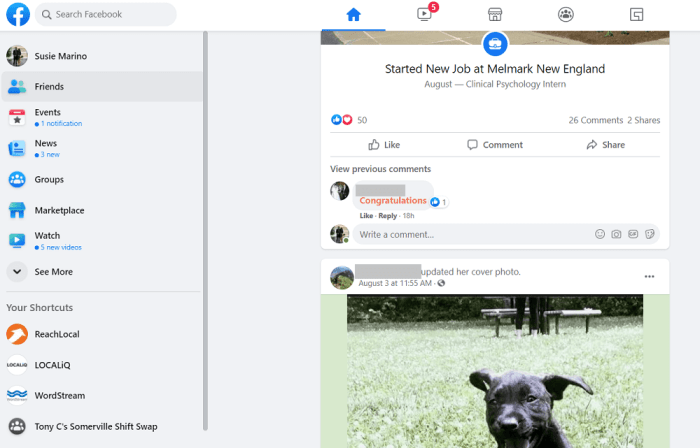Facebook’s News Feed Algorithm Evolution
The Facebook news feed algorithm has evolved dramatically over the years, influencing how we consume content on the platform. From prioritizing chronological order to focusing on personalized relevance, the algorithm has been constantly adapting to cater to user preferences and optimize engagement.
Chronological Order vs. Personalized Relevance
Facebook’s news feed initially displayed content in chronological order, meaning the most recent posts appeared first. This simple approach was transparent and straightforward, but it didn’t account for individual user interests or preferences. As the platform grew, the sheer volume of content made it challenging for users to keep up with their friends and family.
In 2009, Facebook introduced EdgeRank, a more sophisticated algorithm that aimed to prioritize content based on its relevance to individual users. This shift marked a significant change in how users interacted with the platform. EdgeRank considered factors like user engagement with specific content, the strength of their social connections with the poster, and the timeliness of the post.
Facebook’s Shift Towards Prioritizing Content from Friends and Family
In 2018, Facebook announced a change in its algorithm to prioritize content from friends and family over content from pages and public figures. This shift aimed to enhance the social experience on Facebook and encourage more meaningful interactions between users.
Facebook’s rationale behind this change was to address concerns about the increasing prevalence of clickbait and misinformation on the platform. By prioritizing content from friends and family, Facebook hoped to promote authentic connections and reduce the spread of misleading information.
Balancing Content from Pages and Friends
Facebook’s News Feed, the heart of its platform, constantly faces the challenge of balancing content from pages and friends to deliver a personalized and engaging experience for users. This delicate act involves understanding the intricate interplay between user preferences, content characteristics, and algorithmic decisions.
Factors Influencing Content Preference
Users’ preference for content from pages or friends stems from a combination of factors:
- Personal Connections: Content from friends often resonates more deeply because it involves people we know and care about. We are inherently interested in their lives, experiences, and perspectives.
- Content Relevance: Pages cater to specific interests, providing information, updates, and entertainment tailored to our passions. This targeted content can be highly relevant and engaging, especially for niche topics or brands we follow.
- Content Diversity: Friends often offer a broader range of content, reflecting diverse interests and perspectives. This can introduce us to new ideas, opinions, and experiences, contributing to a more well-rounded news feed.
- Emotional Connection: Content from friends often evokes stronger emotional responses due to the personal connection. We are more likely to feel empathy, joy, or sadness when engaging with posts from loved ones.
Facebook’s Attempts to Address User Concerns
Facebook has implemented various features and algorithms to address user concerns about the prominence of either pages or friends’ content:
- “See First” Feature: This allows users to prioritize specific friends or pages in their News Feed, ensuring they see their content more prominently.
- “Most Recent” Feed Option: This option displays posts in chronological order, providing users with a more transparent view of recent activity from both friends and pages.
- “Snooze” Feature: This allows users to temporarily hide posts from specific pages or friends for a set period, providing greater control over their News Feed experience.
- “Unfollow” Feature: Users can choose to unfollow pages or friends to reduce their content visibility in the News Feed, allowing them to curate a feed aligned with their preferences.
- “News Feed Preferences” Settings: These settings enable users to refine their News Feed preferences, including the types of content they want to see, the frequency of posts, and the prominence of specific categories.
Impact of the News Feed Tweak
Facebook’s news feed tweak, aimed at prioritizing content from friends and family over pages and brands, could have a significant impact on how users interact with the platform. This change may affect user engagement, satisfaction, and the visibility of businesses and brands.
Impact on User Engagement and Satisfaction
The news feed tweak could potentially increase user engagement and satisfaction. By surfacing content from friends and family, Facebook aims to foster a sense of connection and community. This could lead to more meaningful interactions and a more positive user experience. Users may find themselves spending more time on Facebook, actively engaging with posts from their social circle.
Potential Consequences for Businesses and Brands
The news feed tweak could have significant consequences for businesses and brands, potentially impacting their reach and visibility. If content from pages and brands is pushed down the feed, it may become less visible to users, leading to a decline in engagement and reach. This could impact marketing efforts, brand awareness, and ultimately, business outcomes.
“The news feed tweak could potentially decrease the reach of businesses and brands, as users may be less likely to scroll through their feeds to find their content.”
Potential Benefits for Users
The news feed tweak could offer several benefits for users who may see more content from their friends and family. It could foster a sense of community and connection, allowing users to stay updated on the lives of their loved ones. This could also lead to more authentic and genuine interactions, promoting a more positive and engaging experience.
“The news feed tweak could potentially enhance the user experience by promoting a more personalized and engaging feed that focuses on content from their social circle.”
User Feedback and Reactions
The news feed tweak, aimed at balancing content from pages and friends, sparked a wave of reactions from Facebook users. Some welcomed the change, praising Facebook for prioritizing personal connections. Others, however, expressed frustration and concerns about the shift, feeling that their preferred content was being suppressed. This diverse feedback highlights the complexity of balancing user preferences with Facebook’s business model.
User Feedback and Concerns, Facebook tweaks news feed to balance content from pages and your friends
Users expressed a wide range of opinions and concerns about the news feed tweak. Here are some common themes:
- Loss of Preferred Content: Many users felt that the tweak led to a decrease in the visibility of their preferred content, such as news articles, blog posts, or content from specific pages. Some complained that their feeds were now dominated by posts from friends, often about mundane or irrelevant topics.
- Algorithm Bias: Concerns arose about the algorithm’s potential bias, with users suspecting that Facebook was favoring certain types of content or pages over others. This led to accusations of manipulation and a sense of being controlled by the platform.
- Reduced Engagement: Some users reported a decline in engagement with the platform, as they felt less inclined to scroll through their news feed when it was filled with content they found uninteresting. This could negatively impact Facebook’s user base and advertising revenue.
- Lack of Transparency: Many users expressed dissatisfaction with the lack of transparency surrounding the algorithm. They wanted more information about how the news feed was being curated and the criteria used to prioritize content.
Facebook’s Response to User Feedback
Facebook acknowledged the user feedback and responded by providing more control over the news feed. They introduced features that allowed users to customize their feed, such as “See First” for preferred pages and “Unfollow” for unwanted content. They also emphasized their commitment to transparency, providing more information about the algorithm and its workings. However, these measures were not universally welcomed, as some users still felt that the algorithm was not responsive enough to their individual preferences.
Implications for Social Media Platforms: Facebook Tweaks News Feed To Balance Content From Pages And Your Friends
Facebook’s news feed tweak has significant implications for other social media platforms. The focus on prioritizing content from friends over pages has sparked a debate about the balance between personalized experiences and the reach of businesses and public figures. This shift could prompt other platforms to re-evaluate their algorithms and content distribution strategies.
Impact on Algorithm Design
The implications of Facebook’s news feed tweak extend beyond Facebook itself, influencing the strategies of other social media platforms. This shift towards prioritizing content from friends over pages suggests a growing emphasis on personalized experiences. Other platforms might adjust their algorithms to reflect this trend, prioritizing user-generated content and fostering a more intimate and engaging social experience.
“This is a big shift for Facebook and it could have a big impact on other social media platforms. They might start to prioritize user-generated content more, which could be good for users who want to see more of their friends and family. But it could also be bad for businesses and public figures who rely on Facebook to reach their audience.”
Content Visibility and User Experience
The news feed tweak highlights the ongoing debate about balancing user experience and content visibility on social media platforms. Facebook’s approach emphasizes personalized content, potentially limiting the reach of pages and businesses. Other platforms might take different approaches, seeking to maintain a balance between user engagement and the visibility of commercial and public content.
- Instagram, for example, might prioritize content from accounts that users actively engage with, while still allowing businesses to reach a broader audience through targeted advertising and influencer marketing.
- Twitter, with its focus on real-time updates and public discourse, might maintain its emphasis on trending topics and public figures, while incorporating features that allow users to curate their own feeds and prioritize content from specific accounts.
Facebook tweaks news feed to balance content from pages and your friends – This news feed tweak is just the latest chapter in the ongoing story of Facebook’s algorithm. As user behavior and preferences continue to evolve, so too will the algorithm. The key question remains: Will this tweak succeed in striking the right balance between personalized relevance and meaningful connections? Only time will tell how users respond and how Facebook adapts its algorithm in the future.
Facebook’s constantly tweaking its news feed to show you the best mix of content from your friends and the pages you follow. But while you’re scrolling through those updates, don’t forget to check out the news that resident evil revelations 2 ps vita release confirmed ! It’s a game that’ll definitely make your feed a whole lot more exciting, especially if you’re a fan of survival horror.
So, go ahead and check out the latest news, and then get back to catching up on your friends’ lives on Facebook!
 Standi Techno News
Standi Techno News

